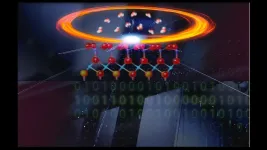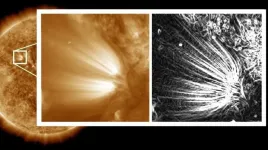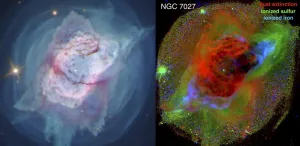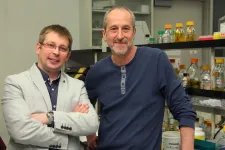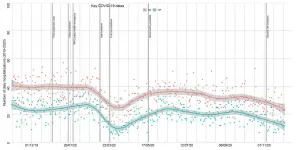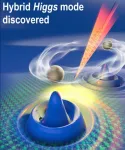Constructing termite turrets without a blueprint
Researchers develop a mathematical model to explain the complex architecture of termite mounds
2021-01-19
(Press-News.org) Following a series of studies on termite mound physiology and morphogenesis over the past decade, researchers at the Harvard John A. Paulson School of Engineering and Applied Sciences have now developed a mathematical model to help explain how termites construct their intricate mounds.
The research is published in the Proceedings of the National Academy of Sciences.
"Termite mounds are amongst the greatest examples of animal architecture on our planet," said L. Mahadevan, the Lola England de Valpine Professor of Applied Mathematics, of Organismic and Evolutionary Biology, and of Physics and lead author of the study. "What are they for? How do they work? How are they built? These are the questions that have puzzled many scientists for a long time."
In previous research, Mahadevan and his team showed that day-to-night temperature variations drive convective flow in the mound that not only ventilates the colony but also move pheromone-like cues around, which trigger building behavior in termites.
Here, the team zoomed in further to understand how termites build the intricately connected floors in individual mounds without a plan or a planner. With experimentalists from the University of Toulouse, France led by Guy Theraulaz, the researchers mapped the interior structures of two nests using CT scans, and quantified the spacing and arrangement of floors and ramps. Adding to the complexity of the nests is the fact that not only do termites build simple ramps to connect floors but they also build spiral ramps, like the ramps in parking garages, to connect multiple floors.
Using these visualizations and incorporating the previous findings on how factors such as daily temperature shifts and pheromone flows drive building, OEB graduate student Alexander Heyde and Mahadevan constructed a mathematical framework to explain the layout of the mound.
Heyde and Mahadevan thought of each component of the mound -- the air, the mud and the termites -- as intermixed fluids that vary in space and time.
"We can think of the collection of hundreds of thousands of termites as a fluid that can sense its environment and act upon it," said Heyde. "Then you have a real fluid, air, transporting pheromones through that environment, which drives new behaviors. Finally, you have mud, which is moved around by the termites, changing the way in which the pheromones flow. Our mathematical framework provided us with clear predictions for the spacing between the layers, and showed the spontaneous formation of linear and helical ramps."
"Here is an example where we see that the usual division between the study of nonliving matter and living matter breaks down," said Mahadevan. "The insects create a micro-environment, a niche, in response to pheromone concentrations. This change in the physical environment changes the flow of pheromones, which then changes the termite behaviors, linking physics and biology through a dynamic architecture that modulates and is modulated by behavior. "
In addition to partially solving the mystery of how these mounds work and are built, the research may well have implications for swarm intelligence in a range of other systems and even understanding aspects of tissue morphogenesis.
INFORMATION:
The research was co-authored by Lijie Guo and Christian Jost. It was supported in part by the US and French National Science Foundations under grant numbers DGE-1144152, ANR-06-BYOS-0008, and PHY1606895.
[Attachments] See images for this press release:

ELSE PRESS RELEASES FROM THIS DATE:
2021-01-19
Computer simulations hold tremendous promise to accelerate the molecular engineering of green energy technologies, such as new systems for electrical energy storage and solar energy usage, as well as carbon dioxide capture from the environment. However, the predictive power of these simulations depends on having a means to confirm that they do indeed describe the real world.
Such confirmation is no simple task. Many assumptions enter the setup of these simulations. As a result, the simulations must be carefully checked by using an appropriate "validation protocol" involving experimental measurements.
"We focused on a solid/liquid interface because interfaces are ubiquitous in materials, and those between oxides and water are key in many energy applications." -- Giulia Galli, theorist ...
2021-01-19
New Rochelle, NY, January 19, 2021--Gene editing therapies, including CRISPR-Cas systems, offer the potential to correct mutations causing inherited retinal degenerations, a leading cause of blindness. Technological advances in gene editing, continuing safety concerns, and strategies to overcome these challenges are highlighted in the peer-reviewed journal Human Gene Therapy. Click here to read the full-text article free on the Human Gene Therapy website.
"Currently, the field is undergoing rapid development with a number of competing gene editing strategies, including allele-specific knock-down, base editing, prime editing, and RNA editing, are under investigation. Each offers a ...
2021-01-19
ITHACA, N.Y. - When the semester shifted online amid the COVID-19 pandemic last spring, Cornell University instructor Mark Sarvary, and his teaching staff decided to encourage - but not require - students to switch on their cameras.
It didn't turn out as they'd hoped.
"Most of our students had their cameras off," said Sarvary, director of the Investigative Biology Teaching Laboratories in the College of Agriculture and Life Sciences (CALS).
"Students enjoy seeing each other when they work in groups. And instructors like seeing students, because it's a way to assess whether or not they understand the material," Sarvary said. "When we switched to online learning, that component got lost. We wanted to investigate the reasons ...
2021-01-19
Scientists have combined NASA data and cutting-edge image processing to gain new insight into the solar structures that create the Sun's flow of high-speed solar wind, detailed in new research published today in The Astrophysical Journal. This first look at relatively small features, dubbed "plumelets," could help scientists understand how and why disturbances form in the solar wind.
The Sun's magnetic influence stretches billions of miles, far past the orbit of Pluto and the planets, defined by a driving force: the solar wind. This constant outflow of solar material carries the Sun's magnetic field out into space, where it shapes the environments around Earth, other worlds, and in the reaches of deep space. Changes in the solar wind ...
2021-01-19
Images of two iconic planetary nebulae taken by the Hubble Space Telescope are revealing new information about how they develop their dramatic features. Researchers from Rochester Institute of Technology and Green Bank Observatory presented new findings about the Butterfly Nebula (NGC 6302) and the Jewel Bug Nebula (NGC 7027) at the 237th meeting of the American Astronomical Society on Friday, Jan. 15.
Hubble's Wide Field Camera 3 observed the nebulae in 2019 and early 2020 using its full, panchromatic capabilities, and the astronomers involved in the project ...
2021-01-19
New high-resolution structures of the bacterial ribosome determined by researchers at the University of Illinois Chicago show that a single water molecule may be the cause -- and possible solution -- of antibiotic resistance.
The findings of the new UIC study are published in the journal Nature Chemical Biology.
Pathogenic germs become resistant to antibiotics when they develop the ability to defeat the drugs designed to kill them. Each year in the U.S., millions of people suffer from antibiotic-resistant infections, and thousands of people die as a result.
Developing new drugs is a key way the scientific community is trying to reduce the impact of antibiotic resistance.
"The first thing we need to do to make improved drugs is to better understand how antibiotics work and how 'bad ...
2021-01-19
Data analysis is revealing a second sharp drop in the number of people admitted to hospital in England with acute heart failure or a heart attack.
The decline began in October as the numbers of COVID-19 infections began to surge ahead of the second lockdown, which came into force in early November.
The findings, from a research group led by the University of Leeds, have been revealed in a letter to the Journal of the American College of Cardiology.
The decline - 41 percent fewer people attending with heart failure and 34 percent with a heart attack compared to pre-pandemic levels ...
2021-01-19
The human brain has about as many neurons as glial cells. These are divided into four major groups: the microglia, the astrocytes, the NG2 glial cells, and the oligodendrocytes. Oligodendrocytes function primarily as a type of cellular insulating tape: They form long tendrils, which consist largely of fat-like substances and do not conduct electricity. These wrap around the axons, which are the extensions through which the nerve cells send their electrical impulses. This prevents short circuits and accelerates signal forwarding.
Astrocytes, on the other hand, supply the nerve cells with energy: Through their appendages they come into contact with blood vessels and absorb glucose from these. ...
2021-01-19
AMES, Iowa - Even if you weren't a physics major, you've probably heard something about the Higgs boson.
There was the title of a 1993 book by Nobel laureate Leon Lederman that dubbed the Higgs "The God Particle." There was the search for the Higgs particle that launched after 2009's first collisions inside the Large Hadron Collider in Europe. There was the 2013 announcement that Peter Higgs and Francois Englert won the Nobel Prize in Physics for independently theorizing in 1964 that a fundamental particle - the Higgs - is the source of mass in subatomic ...
2021-01-19
BROOKLYN, New York, Tuesday, January 19, 2021 - The World Health Organization END ...
LAST 30 PRESS RELEASES:
[Press-News.org] Constructing termite turrets without a blueprint
Researchers develop a mathematical model to explain the complex architecture of termite mounds

